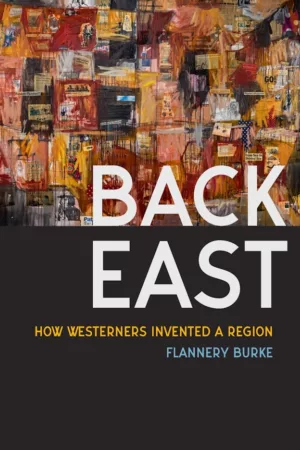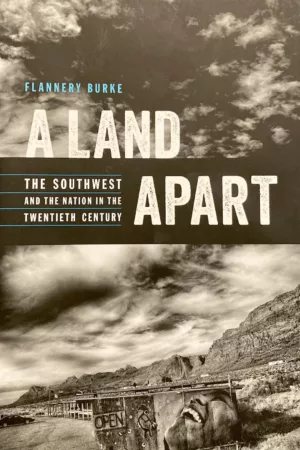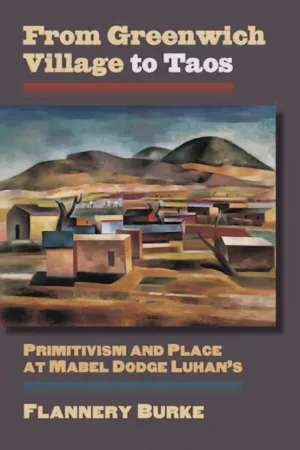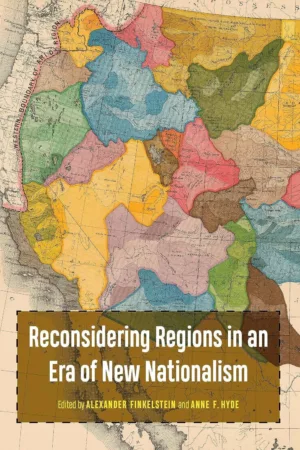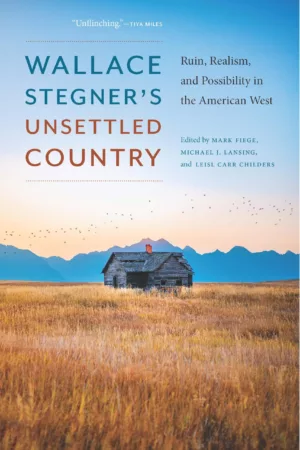
The Ralph Emerson Twitchell Award from the Historical Society of New Mexico
Finalist for the New Mexico Book Prize for History from the New Mexico Humanities Council
They all came to Taos: Georgia O’Keefe, D. H. Lawrence, Carl Van Vechten, and other expatriates of New York City. Fleeing urban ugliness, they moved west between 1917 and 1929 to join the community that art patron Mabel Dodge created in her Taos salon and to draw inspiration from New Mexico’s mountain desert and “primitive” peoples. As they settled, their quest for the primitive forged a link between “authentic” places and those who called them home.
In this first book to consider Dodge and her visitors from a New Mexican perspective, Flannery Burke shows how these cultural mavens drew on modernist concepts of primitivism to construct their personal visions and cultural agendas. In each chapter she presents a place as it took shape for a different individual within Dodge’s orbit. From this kaleidoscope of places emerges a vision of what place meant to modernist artists — as well as a narrative of what happened in the real place of New Mexico when visitors decided it was where they belonged. Expanding the picture of early American modernism beyond New York’s dominance, she shows that these newcomers believed Taos was the place they had set out to find — and that when Taos failed to meet their expectations, they changed Taos.
Throughout, Burke examines the ways notions of primitivism unfolded as Dodge’s salon attracted artists of varying ethnicities and the ways that patronage was perceived-by African American writers seeking publication, Anglos seeking “authentic” material, Native American artists seeking patronage, or Nuevomexicanos simply seeking respect. She considers the notion of “competitive primitivism,” especially regarding Carl Van Vechten, and offers nuanced analyses of divisions within northern New Mexico’s arts communities over land issues and of the ways in which Pueblo Indians spoke on their own behalf.
Burke’s book offers a portrait of a place as it took shape both aesthetically in the imaginations of Dodge’s visitors and materially in the lives of everyday New Mexicans. It clearly shows that no people or places stand outside the modern world — and that when we pretend otherwise, those people and places inevitably suffer.
Praise for From Greenwich Village to Taos
“This highly readable, absorbing account of the artistic community that gathered in Taos through the patronage of Mabel Dodge from 1917 to 1929 is an effective, synthetic addition to a large literature on this legendary self-conscious avant-garde of US modernism.… The volume is well illustrated, with many interesting period photographs.”
“A beautifully textured book that tells the story of Mabel Dodge Luhan and her community in Taos, New Mexico, and explores crucial questions about representation, place, and modernity.… A valuable addition to the scholarship on race and primitivism in the early twentieth century. Beyond those areas, anyone interested in the intersections of race, place, and modernity will find Burke an insightful and informative guide.”
“Drawing on a variety of sources and methods, her contribution will likely attract the attention of scholars across the humanities who are interested in the issues of race and place in the American West.”
“A thoroughly researched, well-written account of Dodge’s transition to Taos from her Greenwich Village apartment .… A fascinating study of Mabel Dodge Lugan and her cohorts’ search for an artistic oasis and an authentic ‘primitivism.’”
“An absorbing and intelligent assessment of the ways in which the cultural landscape of northern New Mexico took shape in the imaginations of art patron Mabel Dodge Luhan and the various literary and artistic figures she attracted to the region between 1917 and 1929.…A well-researched and valuable new synthesis of the ways in which these figures negotiated Luhan’s powerful personality and imbued their subsequent work with the influences of the region’s distinctive landscapes and its Native American and Nuevomexicano populations.”
“Rather than focusing solely on Dodge and Taos, Burke examines the primitivist discourses that connected them to other luminaries orbiting the ‘creative metropole’ of New York City during the 1920s and 1930s.… Burke organizes her study around the interwoven themes of modernism, primitivism, and place.… This book adds much to our knowledge of placemaking in the modern American West. Dodge’s intellectual offspring would do well to read it.”
“Burke commendably records in detail how Luhan was let down by the work that Lawrence did in Taos: among other titles, “St. Mawr,” “The Plumed Serpent,” “Mornings in Mexico” and “A Little Moonshine With Lemon.” They hardly amounted to the triumph she expected when she invited the author of “Women in Love” to her special domain. But Lawrence’s own sense of the primitive — a dark, subintellectual “blood-understanding” between attuned people — was different from Luhan’s simple, natural volkishness. And the control she wanted to exert — as a sort of queen ruling over her ranch-world — was at loggerheads with his odd principles of manliness (and womanliness).… Burke has done her research and neatly documents the tensions in New Mexico among Mexicans, Native Americans and Nuevo-Mexicano “Americans,” residents descended from Mexican families or Spanish-Native American unions. Luhan and her Anglo arts community plunked itself down right in the midst of all this.”
“An impressive book.… Burke’s most important contributions emerge from her study of the responses of Pueblos and Hispanos to the Anglo patronage that complexly supported, benefited, patronized, and undermined their communities, while exacerbating inter-ethnic tensions that were there long before their arrival. In addition, her fresh and exciting analysis of the divisions within the Santa Fe and Taos arts communities and the ways in which Pueblo Indians positioned themselves to speak on their own behalf is just terrific — very nuanced and very compelling.”
Order From Greenwich Village to Taos
